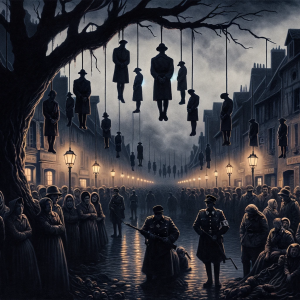In the shadows of World War II, the Tulle Massacre stands as a harrowing testament to the brutalities inflicted by the Nazi regime upon occupied France. On June 9, 1944, the quiet town of Tulle in the Corrèze department was thrust into a nightmare orchestrated by the 2nd SS Panzer Division “Das Reich.” This article delves into the historical context of the massacre, the involvement of the German forces, the ensuing atrocities, and the legacy of this tragic event.
 The Tulle Massacre did not occur in isolation but was part of a broader strategy of repression employed by the Nazis in response to the growing resistance movement in France. Following the D-Day landings on June 6, 1944, the French Resistance, or Maquis, intensified their efforts to disrupt German operations. In Corrèze, this resistance was particularly active, posing a significant threat to German control.
The Tulle Massacre did not occur in isolation but was part of a broader strategy of repression employed by the Nazis in response to the growing resistance movement in France. Following the D-Day landings on June 6, 1944, the French Resistance, or Maquis, intensified their efforts to disrupt German operations. In Corrèze, this resistance was particularly active, posing a significant threat to German control.
The 2nd SS Panzer Division “Das Reich,” under the command of General Heinz Lammerding, was tasked with quelling the resistance and reasserting German dominance. This division, notorious for its ruthlessness, embarked on a campaign of terror that culminated in the massacre at Tulle.
On June 7, 1944, resistance fighters launched an attack on Tulle, temporarily liberating the town. However, their victory was short-lived. The following day, the 2nd SS Panzer Division arrived, determined to crush the uprising. The Battle of Tulle ensued, marked by fierce combat and significant casualties on both sides. By June 9, the Germans had regained control of the town, setting the stage for a brutal crackdown.
In the aftermath of the battle, the Germans conducted mass arrests, rounding up nearly all male citizens aged 16 to 60. These hostages were herded into a local factory where they faced a grim selection process. The criteria for execution were arbitrary, often based on superficial judgments of appearance and demeanor.
The massacre reached its horrific climax as 99 men were chosen for execution. Eyewitness accounts, including that of Father Espinasse, describe the gruesome scene that unfolded. The victims were hanged from lamp posts, balconies, and trees along the main streets of Tulle. The brutality was unrelenting; some victims were forced to climb ladders to their deaths, only to be kicked away by their executioners. The streets of Tulle were transformed into a macabre display of Nazi terror.
The horror did not end with the hangings. Approximately 149 additional hostages were deported to concentration camps, many of whom perished in the inhumane conditions. The Chantiers de Jeunesse, a Vichy regime youth organization, played a role in the selection process for deportation, further highlighting the collaboration between the occupying forces and certain elements of French society.
The massacre at Tulle sent shockwaves throughout France and the Allied world. It was a stark reminder of the lengths to which the Nazi regime would go to maintain control and punish dissent. The immediate reaction was one of horror and outrage, but the long-term response included a renewed determination to resist and ultimately defeat the occupiers.
In the years following the war, extensive research has been conducted into the events at Tulle. Historians have sought to document the massacre, relying on eyewitness testimonies, military records, and other primary sources. However, revisionist narratives, often based on German accounts, have attempted to downplay the scale of the atrocities or justify the actions of the 2nd SS Panzer Division. These efforts have been met with vigorous opposition from scholars committed to preserving the truth.
The legacy of the Tulle Massacre endures as a symbol of resistance and a reminder of the atrocities committed during the Nazi occupation. Memorials in Tulle honor the victims, and annual commemorations ensure that the memory of this dark chapter in history is not forgotten. The massacre also serves as a poignant reflection on the human capacity for both cruelty and resilience.
In remembering the Tulle Massacre, we confront the horrors of the past while reaffirming our commitment to justice and the protection of human rights. It stands as a solemn reminder of the cost of freedom and the enduring importance of historical truth.
Leave a comment